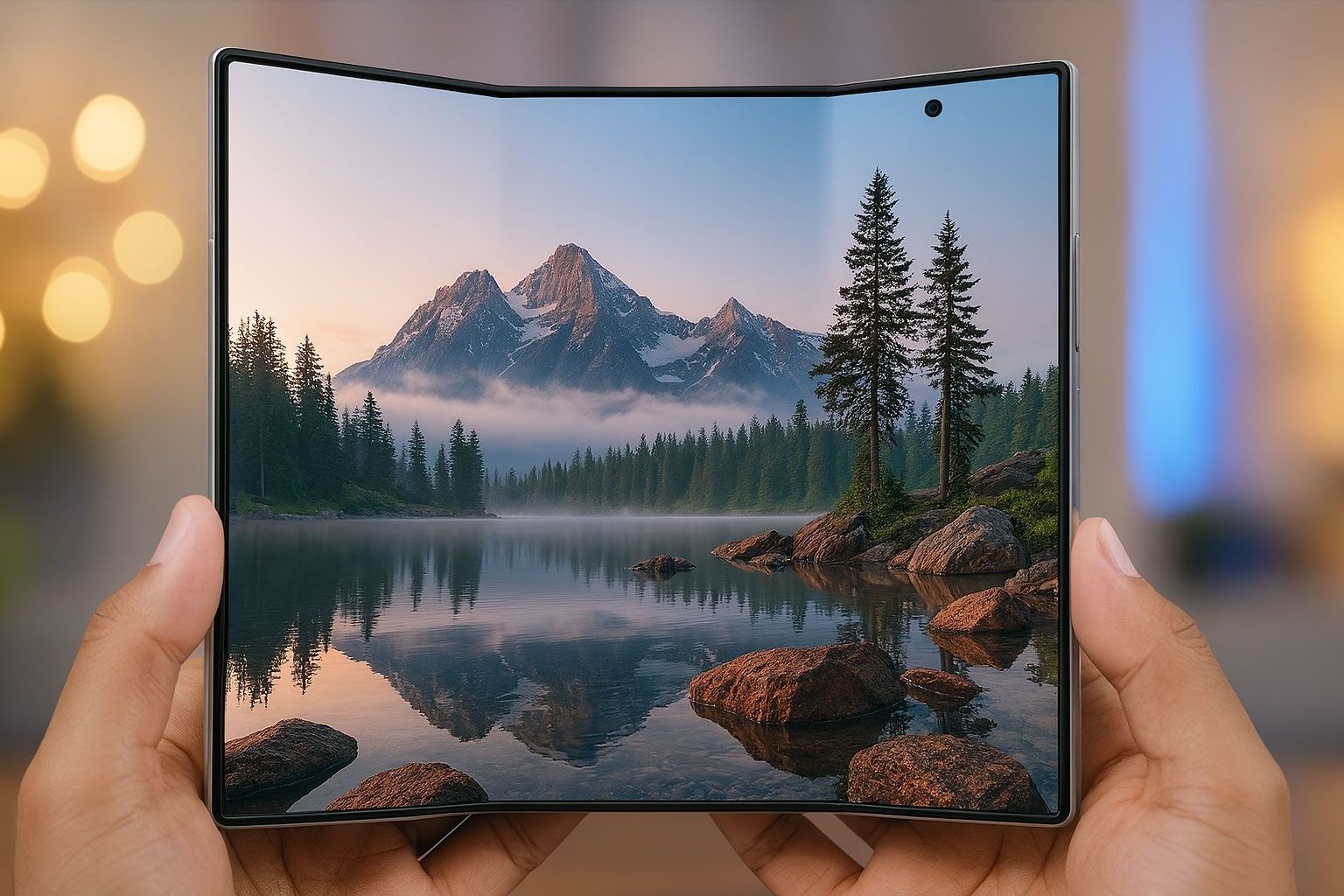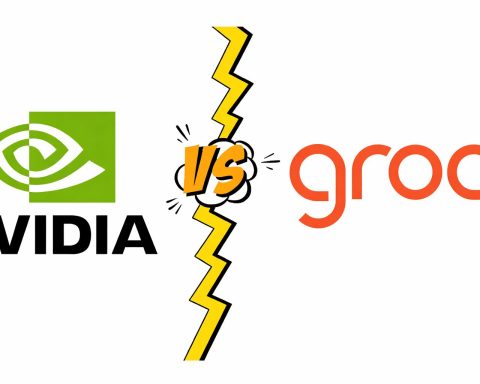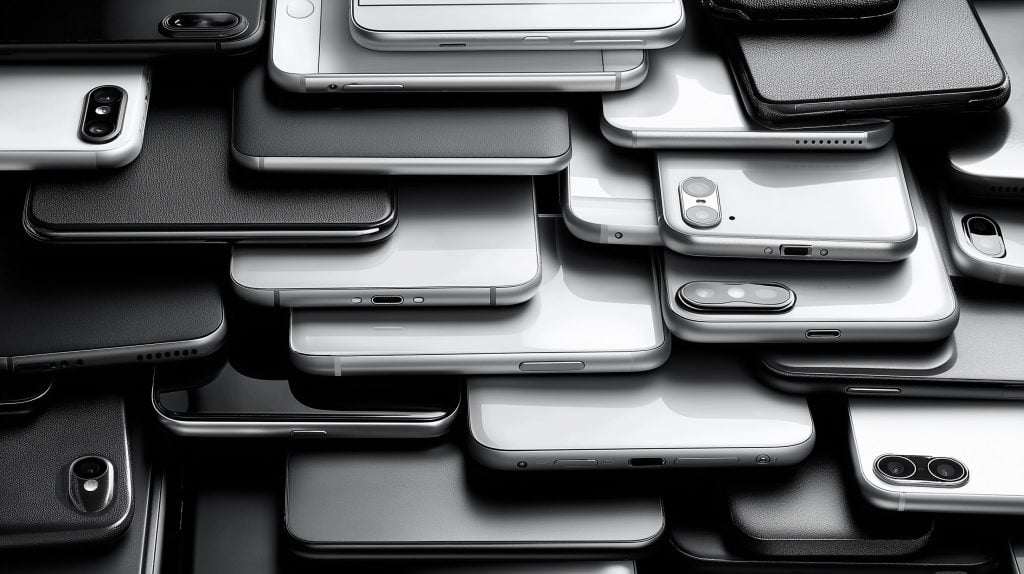- The Galaxy G Fold is a tri-foldable smartphone with three panels and two inward-folding hinges forming a G shape, able to unfold into about a 10-inch tablet and fold to a 6.49-inch cover phone.
- Roh Tae-moon stated in a July 2025 press briefing after Galaxy Unpacked that Samsung aims to launch the tri-fold by the end of 2025.
- Samsung has patent applications from 2021–2023 showing two hinges and three display segments, and CES 2022 showcased multi-folding prototypes Flex S and Flex G.
- At MWC Barcelona in early 2025, Samsung exhibited an updated Flex G concept with three interconnected panels, no external display in the prototype, and a cover display planned for usability.
- The unfolded internal display is expected around 9.8–10 inches, with a 6.49-inch cover screen, with some leaks citing 9.96 inches unfolded and about 6.5 inches in portrait.
- The G Fold is tipped to use a Qualcomm Snapdragon 8 Gen 4 processor, with 12 GB of RAM and 256 GB base storage, possibly with LPDDR5X and UFS 4.0.
- A triple rear camera is expected on the left panel, with rumored specs around a 50 MP main sensor, 12 MP ultrawide, and 10 MP telephoto; a 10 MP front camera on the cover, and a possible under-display camera on the inner screen.
- Leaks suggest a multi-cell battery around 5,000 mAh total capacity, with 25W wired charging, 15W wireless charging, and reverse wireless charging.
- The tri-fold is not expected to support the S Pen at launch due to the challenge of adding a digitizer across three panels.
- The initial Galaxy G Fold release is planned for late 2025 as a limited, regional launch (likely South Korea and China) with production rumored under 300,000 units.
Introduction: Samsung Galaxy G Fold Triple Foldable Phone
Samsung is reportedly gearing up to launch a game-changing triple-folding smartphone – an ambitious device rumored to be called the Galaxy G Fold. This tri-foldable handset would fold twice to transform from a phone into a tablet, marking a major evolution in Samsung’s foldable lineup. Industry insiders and patent filings have hinted at this project for years [1] [2], but now official statements and credible leaks suggest 2025 could finally be the year we see Samsung’s first tri-fold phone [3] [4]. From Samsung’s own patent drawings and prototype demos to spy shots in software and tipsters’ reports, we’ve gathered everything known so far – including design concepts, leaked specs, expected release timing, and how the G Fold fits into Samsung’s grand plan. Read on for a comprehensive deep dive into the Galaxy G Fold: Samsung’s rumored triple-foldable smartphone poised to redefine mobile innovation.
Samsung Confirms a Tri-Foldable Is Coming
For a long time, the tri-fold Galaxy G Fold existed only in rumors. That changed in mid-2025 when Samsung executives publicly acknowledged the device’s existence and launch plans. During a press briefing after the Galaxy Unpacked July 2025 event in New York, Samsung’s mobile chief Roh Tae-moon (TM Roh) stated: “We are working hard on a tri-fold smartphone with the goal of launching it at the end of this year”, confirming that the company is targeting a release by late 2025 [5]. He added that Samsung is “focusing on perfecting the product and its usability” and that the final name hadn’t been decided yet, even as rumors widely refer to it as the Galaxy G Fold [6]. This was a significant official green light – after years of hints, Samsung was finally saying a triple-foldable is on the near-term roadmap.
Samsung had dropped earlier clues as well. In late 2024, during a quarterly earnings call, an executive teased that “a new form factor” was in development and would launch once it met Samsung’s quality standards [7]. “We are also preparing a new form factor for consumers who want a more powerful and innovative mobile experience,” said Samsung EVP Daniel Araujo, “and we plan to introduce the product to the market when we have secured satisfactory quality and experience in the actual usage environment” [8]. This strongly hinted at the tri-fold device. By early 2025, Korean media reports suggested that Samsung was sharing a product roadmap for a double-hinged foldable with suppliers: plans were reportedly in place to start limited production by September 2025 and launch within the fourth quarter of 2025 [9] [10]. Samsung’s goal, according to these reports, was to beat competitors to market and reinforce its foldable leadership, even if that meant a cautious initial release with low volumes [11].
Notably, Samsung’s confirmation came on the heels of Huawei releasing the world’s first commercial tri-fold phone, the Mate XT, in late 2024. The Mate XT’s debut seemingly put pressure on Samsung. Roh Tae-moon acknowledged that Samsung pioneered the foldable phone category in 2019 with the Galaxy Fold and welcomed that more companies (like Huawei – and potentially Apple in the future) were now joining the foldable race [12] [13]. Internally, Samsung appears to view the tri-fold G Fold as a way to “strengthen its dominance” in foldables and leap ahead of rivals [14] [15]. In fact, Roh expressed confidence that foldables will remain central in the smartphone era and hinted that multiple new form factors (including tri-folds) will “complement smartphones and complete the ecosystem” going forward [16]. In short, Samsung has officially put the industry on notice: a triple-fold Galaxy device is in the pipeline, and it could arrive as early as late 2025 barring any last-minute delays.
Patents and Early Tri-Fold Concepts
Long before Samsung’s execs spoke openly, the company’s engineers were busy filing patents and building prototype designs for multi-folding devices. There are Samsung patent applications dating back to at least 2021-2023 that depict phones with two hinges and three display segments [17]. These technical drawings showed various configurations – some folding in a zigzag “S” shape, others folding like a “G” with both sides inward – illustrating Samsung’s exploration of the concept. While patents don’t always become products, they signaled that Samsung was seriously considering tri-foldable designs years ago, laying the groundwork for what would eventually be the Galaxy G Fold.
In fact, Samsung publicly showcased prototype hardware for tri-folding screens as early as CES 2022. At that trade show, Samsung Display (the panel-making arm of Samsung) unveiled two multi-folding OLED concepts: one dubbed “Flex S” and another called “Flex G.” The Flex S concept folded in a zigzag with one inward and one outward hinge (forming an “S” shape), whereas the Flex G folded both segments inward on top of each other (a “G” shape when viewed from the side) [18] [19]. Samsung Display explained the rationale: folding twice inwards (Flex G) protects the screens by sandwiching them inside, improving durability against drops or impacts [20]. An insider cited in Korean media noted that Samsung “chose the double-infolding form considering reliability issues,” since an outward fold leaves the display exposed and vulnerable [21]. The inward-folding G-shape concept was thus deemed sturdier, though it means the device would need a separate external screen for use when fully closed. The Flex S (outward + inward) allows one of its display panels to act as an outer screen, but at the cost of exposing part of the flexible display at all times [22]. Samsung’s decision suggests it prioritized screen protection and longevity for its first tri-foldable.
At subsequent events, Samsung continued to tease its tri-fold innovations. In early 2025, at MWC Barcelona, the company reportedly exhibited an updated Flex G concept device believed to be an early prototype of the Galaxy G Fold [23]. Attendees saw a device with three interconnected panels that could unfold into a large tablet-like screen, then fold up into a more compact form. Observers noted it had no visible external display in the prototype – aligning with the inward “G-fold” design – though it’s expected the commercial version will include a cover display for usability [24] [25]. By mid-2025, Samsung even inadvertently showed its hand through software: an animation file hidden in a beta of One UI 8 (Samsung’s Android interface) depicted a device with two hinges, exactly like a tri-fold phone [26] [27]. This leak, uncovered by Android Authority, gave a first visual confirmation of the G Fold’s likely design and was quickly circulated among tech watchers.
All these clues paint a clear picture – Samsung’s tri-foldable didn’t come out of nowhere. It’s the result of years of R&D, patenting novel hinges, and refining prototypes from trade show demos to something consumer-ready. The rumored name “Galaxy G Fold” itself nods to the G-shaped inward folding mechanism that Samsung has been championing [28]. Unlike the existing Galaxy Z Fold series (single hinge, book-style fold), the “G” branding signals a new category altogether. Industry analysts have noted that Samsung Display has been showing off the G-type multi-fold concept for over three years now [29]. With competitors like Huawei proving the concept can be commercialized, Samsung appears determined to launch its own tri-fold – leveraging its patents and prototype experience to hopefully deliver a more polished execution.
A Closer Look at the Tri-Fold Design
So what will the Galaxy G Fold actually look like? Leaks suggest it will effectively be a folding tablet that collapses into a thick but pocketable phone. The device is expected to have three panels with two hinges, allowing it to unfold into one large continuous display roughly the size of a small tablet (around 10 inches). When it’s fully open, you get an expansive screen for multitasking, productivity, or entertainment – truly tablet-sized real estate in a mobile device. But the magic is that this screen can fold twice to become a much smaller package for portability.
Importantly, Samsung’s design uses dual inward-folding hinges – meaning both side panels fold inward over the central panel (imagine two doors closing toward the middle). This is the “concertina” style or “G” shape configuration. By folding inward, the delicate flexible screen on each segment is protected on the inside when the device is shut, similar to how the current Galaxy Z Fold’s inner display is hidden when closed. According to leaked One UI 8 animations and insider reports, the Galaxy G Fold will indeed follow this approach: it has two hinges folding inward and no part of the main display exposed externally when fully folded [30] [31]. Instead, it features a dedicated cover screen on the center section’s exterior for use as a normal phone interface [32]. In other words, when you fold it up, you’ll see a front display (like a regular phone screen) and likely a rear camera module – but the big flexible panels will be tucked safely inside.
Leaked design details from animation files give us a fairly specific idea of the layout. Viewed from the back (hinges facing you), the left panel of the tri-fold is shown housing a triple-camera array – presumably the rear cameras [33]. The middle panel has the cover display on its outward face, along with a front-facing selfie camera (likely a punch-hole or under-display camera on that cover screen) [34]. The right panel apparently does not have an external display; it serves as part of the internal screen and forms the innermost layer when everything is folded [35]. When closing the device, the sequence will matter: insiders say the G Fold’s hinges are slightly asymmetric, requiring users to fold the left section in first, then the right on top of it [36]. In fact, Samsung’s software is coded to warn you if you attempt to fold the wrong side first [37] – a small usability tweak to ensure the hinges and screens aren’t put under undue stress. Once both sides are folded in, the left panel (with the cameras) ends up on the very top, facing outward, and the right panel gets tucked inside, sandwiched between the left and center. This leaves the cover screen (on the center panel’s outside) visible on the front of the folded device for at-a-glance info and basic usage [38].
When fully unfolded, the internal display spans roughly 9.8 to 10 inches diagonally – essentially creating a tablet experience [39] [40]. For context, that’s larger than the 7.6-inch screen on the current Galaxy Z Fold 6/7, and even a bit bigger than an iPad mini. The aspect ratio will likely be almost square or slightly rectangular. One leak pegs the unfolded screen size at approximately 9.96 inches [41] with a nearly 6.5-inch height when held in portrait [42]. The cover display on the outside is said to be 6.49 inches [43] [44] – interestingly, the exact same size as the Galaxy Z Fold 7’s external screen [45] [46]. In fact, renowned display analyst Ross Young revealed that Samsung’s first tri-fold’s cover panel will be 6.49″, matching the Fold 7, suggesting Samsung might reuse or closely spec the G Fold’s cover screen to its conventional foldable for efficiency [47] [48]. However, unlike a normal Fold, the G Fold’s cover screen sits on the middle segment (with bezels on top and bottom, likely) rather than spanning one half of the device – a necessary design choice because the G Fold has three parts rather than two.
Ergonomically, a tri-fold will be a thick device when folded up – effectively stacking three layers of screen and two hinge mechanisms. Leaks claim the Galaxy G Fold will be thicker and heavier than Huawei’s Mate XT (which itself weighs about 300g) [49]. It might be a bit of a brick in phone mode, but it promises a much larger canvas when opened. Samsung is reportedly using new materials and hinge designs to manage this complexity. One tipster claims the G Fold will use a next-generation flexible display with an improved protective ultra-thin glass or film to prevent “tearing at the seams” despite the multiple folds [50] [51]. Samsung Display has plenty of experience from the Fold series and has iterated on hinge durability (water-drop hinge designs, multi-axis folding, etc.), so we expect the G Fold to incorporate the latest hinge tech for a smooth folding action and minimal seam gap. Whether the device will have any hinge waterproofing or dust resistance (like the latest Z Fold/Flip’s IPX8 rating) remains unknown – engineering a water-resistant dual hinge could be very challenging.
In summary, Samsung’s tri-fold design philosophy seems to be: make it robust and seamless as a tablet first, even if that adds some bulk in phone form. By folding inward in a G-shape, the Galaxy G Fold should have no exposed flexible screen edges when closed, maximizing protection [52]. It will function as a normal smartphone when folded thanks to its cover display, and then unfold into a mini tablet for tasks that need a larger screen. The form factor is likely to attract power users and tech enthusiasts who want the ultimate mobile productivity device – essentially combining a phone and tablet into one.
Rumored Specs and Features
Beyond the novel form factor, what kind of specifications can we expect from the Galaxy G Fold? Samsung will undoubtedly equip this flagship foldable with top-tier hardware, though some compromises might be needed given the space constraints and power requirements of a tri-fold device. Here’s what the rumor mill and leaks suggest in terms of internals and features:
- Display Technology: The inner folding display will almost certainly use Samsung’s Flexible AMOLED tech with an ultra-thin glass (UTG) layer, similar to the Z Fold series but likely an upgraded version to handle two folds. It might have a slightly lower pixel density than smaller foldables due to its near-10-inch size, but expect a high resolution (QXGA+ or higher) for clarity in tablet mode. The cover screen (6.49″) will probably be a standard Dynamic AMOLED panel around FHD+ resolution, similar to other Galaxy flagships [53] [54]. Both screens will likely support 120Hz adaptive refresh rate for smooth visuals, a staple on Samsung’s premium devices.
- Processor: According to leaks from Korean and Chinese sources, the Galaxy G Fold is tipped to launch with the Qualcomm Snapdragon 8 Gen 4 chipset (or equivalent) [55]. This would line up with Samsung’s 2025 flagship cycle – the Galaxy S25 series is expected to debut the Snapdragon 8 Gen 4, so the G Fold arriving later in the year would use the same next-gen silicon. The Snapdragon 8 Gen 4 (sometimes referred to as “8 Elite” in early reports [56]) should provide cutting-edge performance, with improved CPU efficiency and GPU power to handle the large display and multitasking. In some markets, Samsung might alternatively use an Exynos processor if a high-end one is available, but given recent trends, sticking to Qualcomm for foldables is more likely.
- Memory and Storage: Rumors point to 12 GB of RAM and 256 GB of base storage for the G Fold [57]. This is on par with other premium foldables – ample RAM to enable heavy multitasking (like running three apps side-by-side on that big screen) and a base storage sufficient for media and apps (with higher 512GB or 1TB variants possibly offered, as Samsung often does for its Fold line). The RAM is expected to be the latest LPDDR5X and storage UFS 4.0 or newer for fast read/write speeds.
- Cameras: Samsung is likely to equip the Galaxy G Fold with a triple rear camera system, as indicated by the leaks showing three lenses on the left panel [58]. The exact camera specs haven’t leaked in full, but we can speculate it may borrow from the Galaxy S or Z Fold series. Perhaps a wide, ultrawide, and telephoto setup – for example, a 50MP main sensor, 12MP ultrawide, and 10MP 3x telephoto (similar to the Z Fold 7’s rumored camera setup). However, given the device’s thickness, Samsung might opt for slightly smaller sensors to save space. Don’t expect the absolute best camera hardware (which is reserved for the S Ultra series), but it should be competitive with other foldables. The front-facing camera on the cover screen will likely be a punch-hole camera (10MP range), and there could be an additional under-display camera (UDC) on the internal large screen for video calls in tablet mode – similar to how the Galaxy Z Fold has an under-display camera on its inner screen. If so, the quality might be modest (4MP or under) but it keeps the big display uninterrupted. It’s also possible Samsung foregoes an inner selfie camera and encourages using the rear cameras with the cover screen as viewfinder (a trick foldables can do), but that remains to be seen.
- Battery: Fitting a battery into a triple-section phone is challenging, but leaks suggest Samsung will use a multi-cell design to deliver around ~5,000 mAh or slightly more total capacity [59]. This would be impressive, as the current Z Fold 5/6 have ~4,400 mAh. The extra space of a larger device could allow a larger battery, though it also has to power a much bigger screen. Samsung reportedly may use a new battery tech (there was speculation about stacked “bi-cell” batteries or even solid-state in some reports), but more concrete rumors point to just a high-density Li-ion battery. Fast Charging is rumored to stick to Samsung’s standard 25W wired charging [60], not the 45W seen on some Galaxy S Ultras. This is likely due to thermal considerations in a foldable frame. Wireless charging (possibly 15W) and reverse wireless charging should also be supported, as they are on current Galaxy foldables.
- S Pen Support: One somewhat disappointing rumor is that the Galaxy G Fold might not support the S Pen stylus – at least not at launch. Reports indicate the device may lack the digitizer layer needed for stylus input on its flexible screen [61]. Samsung’s existing Fold series only gained optional S Pen support with the Fold3, and even then the stylus works only on the inner display and requires a special Fold Edition pen (to limit force on the screen). For the tri-fold, adding a digitizer across a multi-folding panel could increase thickness and complexity. So, as of now, insiders say no S Pen support is planned for the first-gen G Fold [62] – which could disappoint Galaxy Note loyalists and Fold users who enjoy pen input. Samsung may revisit this in future iterations as technology improves. For now, the focus seems to be on getting the form factor right, rather than adding stylus functionality.
- Software and Multitasking: The Galaxy G Fold will ship with an optimized version of Samsung’s One UI, likely One UI 8 or newer on top of Android 14/15 (depending on timing). Samsung has been enhancing its multi-window and large-screen features with each generation, so expect powerful multitasking: the ability to run three or more apps simultaneously in resizable windows or split-screen on that 10″ display. There may be specialized UI tweaks for tri-fold – for instance, dragging content across three panels, or continuity that shifts an app’s layout as you fold or unfold one section. The One UI 8 animation leak already revealed an NFC chip indicator in one panel, showing Samsung is accounting for the unique hardware in software [63]. We can anticipate improvements to Flex Mode (using one part of the screen as a keyboard or controller, etc.) and perhaps new use-cases for a tri-fold configuration. Given Samsung’s partnership with Google on foldables, the G Fold will likely leverage Android’s latest foldable features and maybe some exclusive tweaks to handle the “three-part screen” dynamic.
- Connectivity and Other Features: As a flagship, the Galaxy G Fold will have 5G connectivity, the latest Wi-Fi 7 and Bluetooth standards, stereo speakers (possibly more than two speakers for a better tablet media experience), and an array of sensors. Its fingerprint scanner will probably be side-mounted (integrated into the power button) as in the Z Fold series, since under-display fingerprints don’t work on flexible screens yet. It should also support Samsung DeX, Samsung Pay, ultra-wideband (for Digital Key and tracking), and all the premium bells and whistles. One lingering question is durability: Samsung is likely to advertise a certain number of hinge cycles (e.g. tested for 200,000+ folds) like it does for its other foldables, and possibly an “Armor Aluminum” frame or other reinforcements. However, due to the complexity, initial units might be more fragile than a typical slab phone. This device will definitely come with care instructions – e.g., not pressing too hard on the screen, keeping it away from dust or sharp objects, etc., much like earlier Folds.
In short, the Galaxy G Fold is poised to be an absolute powerhouse in specs, comparable to Samsung’s top flagship phones, but with some adjustments made for the unconventional form factor. It might not push the envelope in areas like camera resolution or charging speed (given the physical constraints), but it will pack enough high-end hardware to justify its expected premium status. Most important will be how well Samsung integrates the software with the hardware – ensuring that using the G Fold feels intuitive whether you’re using it folded or unfolded. Given Samsung’s experience with the Fold and Flip series, there’s optimism that the G Fold will deliver a polished experience despite being a first-gen product in a new category.
Release Date and Limited Launch Strategy
All signs point to Samsung launching the Galaxy G Fold in late 2025, though the exact timing and launch strategy indicate it will be a cautious, limited release at first. Samsung’s TM Roh explicitly stated the tri-fold is planned to “launch at the end of this year” (meaning 2025) if all goes well [64]. In line with that, Korean industry sources report that mass production of key components (like the folding OLED panels) will begin by September 2025 [65], setting the stage for a product launch in Q4 2025 [66]. This could position the Galaxy G Fold to be unveiled in late fall – possibly at a standalone event or a tech trade show – and released around the end of the year.
However, don’t expect a global, iPhone-scale rollout on day one. Multiple insiders and leakers have claimed that Samsung will adopt a limited market release initially [67] [68]. Specifically, the Galaxy G Fold is rumored to only be available in a few regions at first – likely Samsung’s home base of South Korea and perhaps China (and possibly select nearby Asian markets) [69] [70]. This wouldn’t be unprecedented; for example, Samsung launched a special edition Fold (the Galaxy W21/Fold Special Edition) exclusively in China before, and it often tests limited models in specific markets. In this case, the reasoning is that the G Fold is a brand-new form factor with very high production costs and unknown consumer demand, so Samsung may opt to release it in “selected markets” as a pilot run [71] [72]. An outlet in Hong Kong, citing Samsung insiders, said the G Fold “won’t be sold globally at first, only in a few markets initially” and that initial production will be very limited in quantity [73] [74].
How limited? According to reports from supply chain sources, Samsung is preparing only a small batch of these tri-fold phones, at least in the first production run. One figure that surfaced is under 300,000 units for the initial production lot [75], which is a tiny number by Samsung’s standards. (For comparison, Samsung shipped roughly 8-10 million foldable phones in 2022 across all models, and it usually produces a few million of each Z Fold/Flip per year.) One Korean report even put it as low as ~200,000 units for 2025 [76] [77]. Samsung appears to be treating the G Fold as an exclusive, halo device – more a technology showcase than a mass-market phone, at least at launch [78] [79]. This strategy would allow Samsung to assess the market response and iron out any production kinks without committing to huge volumes. As The Bell (a Korean tech publication) noted, the complex form factor and expensive components make the tri-fold very costly to produce, so a limited run also helps Samsung manage its profit margins and avoid excess inventory [80] [81]. In essence, Samsung can create a aura of exclusivity (enticing early adopters) while minimizing risk.
The geographical limitation – likely focusing on South Korea and China – could be because those markets have been particularly enthusiastic about foldables (China especially has multiple brands pushing foldable innovations). Samsung may want to counter Huawei’s Mate XT on its home turf (China) and simultaneously reward the loyal domestic base in Korea with first dibs on the futuristic device [82]. A broader international launch (e.g. in North America or Europe) might come later, possibly if a second-generation tri-fold is released with higher production. Indeed, Tom’s Guide notes that if the G Fold is only in Korea/China initially, consumers in the US/UK may have to wait for a “G Fold 2” that hopefully gets a wider release [83].
Timing-wise, there was earlier speculation that the tri-fold could be teased alongside the Galaxy Z Fold 7 and Z Flip 7 at the July 2025 Unpacked event [84] [85]. Samsung did decide not to showcase it on stage then, likely to keep focus on the mainstream Fold/Flip and because the tri-fold wasn’t ready for immediate release. However, TM Roh’s confirmation came at that time off-stage, and some insiders believe Samsung might do a separate unveil towards year-end when the device is closer to shipping [86] [87]. There is also a chance Samsung could slip the launch to early 2026 if last-minute issues arise – notably, Ross Young had initially predicted an early 2026 launch for the tri-fold, before Samsung’s public statements suggested otherwise [88] [89]. As of now though, all official commentary from Samsung indicates a target of late 2025. If they manage to hit that, Samsung would get the G Fold on the market within about a year of Huawei’s tri-fold and well ahead of any potential Apple foldable (Apple isn’t expected to debut a foldable iPhone or iPad until 2026 or later) [90] [91].
For those eager to buy one, keep in mind: even if it launches in December 2025, availability might be extremely limited, possibly selling out quickly in the few regions it’s offered. It may not officially come to Western markets initially. Importers will no doubt get some units out, but expect sky-high prices (more on that next) and low supply. Samsung is likely to use the first-gen Galaxy G Fold to gauge interest – if it sees strong demand and solid performance, it could ramp up production for a wider global release in the next iteration. The company did file for trademarks on names like “Flex G” and “Flex S” in some markets, which could hint at eventual global marketing, but nothing is certain yet.
In summary, the Galaxy G Fold is set for a late 2025 debut with a measured rollout. It’s a prudent approach for such bleeding-edge tech. Samsung is deliberately treating it as an experimental ultra-premium device, almost akin to a concept car in the auto industry – real and for sale, but only to a select few at first. The rest of the world may have to watch from afar (or online) until Samsung is confident enough to bring tri-folds into the mainstream.
Price Tag and Market Expectations
If you thought today’s foldable phones were expensive, brace yourself – the Galaxy G Fold is rumored to carry an eye-watering price. Multiple leaks point to a price in the range of $2,500 to $3,500 USD for Samsung’s tri-fold, depending on configuration [92] [93]. In one report, an insider pegged the target price around $2,900 [94]. Another rumor suggested Samsung was considering $3,000 to $3,500 as the possible MSRP, given the device’s complexity and costs [95]. For context, the Galaxy Z Fold 7 (Samsung’s conventional foldable for 2025) starts at around $1,999 [96]. And Huawei’s Mate XT Ultimate (the triple-fold rival) costs roughly CNY 20,000 in China – about $2,800 – for its base model [97] [98]. So a Samsung tri-fold could easily surpass $3k, making it one of the most expensive smartphones ever sold.
Sticker shock aside, it’s understandable – essentially you’re buying a phone + tablet hybrid with cutting-edge display tech and twice the hinges. Samsung also likely wants to signal exclusivity and cover its R&D and production costs with a high price. Even at $3,000, the G Fold might not be very profitable per unit initially, according to analysts, due to its expensive components (multiple OLED panels, complex hinge systems, etc.) [99]. The company has purportedly emphasized that this product is more about tech leadership than sales volume – a “showcase” device to underscore Samsung’s innovation edge [100] [101].
Market-wise, expectations are being set accordingly. Samsung executives have hinted that the tri-fold is being perfected for an “actual usage environment” but also tempered expectations by not even committing to a name yet [102]. The limited production plans indicate Samsung is not counting on huge sales – it’s testing the waters among enthusiasts and luxury tech consumers first. Industry experts are mixed on who the Galaxy G Fold is really for. Tech journalists have mused that this first tri-fold may be “more of a proof of concept than an actual phone” for the average user [103] [104]. “Honestly, it feels like the phone is more about proving a point than anything else,” wrote one commentator, noting that Samsung seems keen to demonstrate it can make a triple-fold device, even if it’s not yet a practical buy for most people [105] [106]. The target demographic initially will be early adopters, tech aficionados, and perhaps professionals who see value in having a folding tablet-phone – and who don’t mind paying the early adopter tax.
That said, Samsung does believe there is a segment of consumers who want “a more powerful and innovative mobile experience” at any cost [107]. The Galaxy G Fold is also a strategic play to keep Samsung’s most loyal, high-spending customers within its ecosystem. It’s the kind of device that will grab headlines and draw crowds at Samsung stores, even if only a handful can afford it. If it succeeds or if demand outstrips the small supply, Samsung could ramp up production in subsequent generations and gradually bring the price down (much like how the original Galaxy Fold was $1,980 but newer Z Folds have added more for similar or slightly less money). Market analysts predict that foldables, including new form factors like tri-folds, will continue to grow and could account for a sizable chunk of the premium phone market by the late 2020s [108]. Samsung likely wants to maintain its dominance in that space, especially as Chinese brands innovate fast and Apple eyes entry later on.
From a broader perspective, the Galaxy G Fold’s launch will be a litmus test for the appetite for ultra-advanced foldables. If it sells out its limited run quickly in Korea/China, that’s a strong signal that there’s consumer hunger for more screen real estate and unique form factors – even at very high prices. It could encourage Samsung (and others) to invest more in multi-fold devices and drive costs down. On the other hand, if it struggles to find buyers or if early user feedback is lukewarm (perhaps due to ergonomics, software quirks, or durability concerns), Samsung might regroup and refine the concept further before pushing it mainstream.
There is optimism within some circles that the G Fold could “reignite excitement in phones again”. Foldables have already injected innovation into a stagnating smartphone market, and a tri-fold is the next level. “The upcoming Galaxy G Fold could be just the thing we need to get excited about phones again,” writes Gizmodo’s Florence Ion, arguing that gadget lovers bored by slab phones will flock to something as fresh as a triple-folding device [109] [110]. She and others note that Samsung, by releasing the G Fold, would show it’s still pushing boundaries in hardware – an important message as some have criticized recent Galaxy phones for iterative upgrades [111] [112]. Enthusiasts are especially intrigued by the multitasking possibilities: the G Fold could be the ultimate mobile productivity machine (think running three apps at once, or editing videos on a tablet screen and then folding to pocket it). This halo effect can boost Samsung’s brand image as an innovator, even among those who won’t purchase the first-gen device.
In summary, expect the Galaxy G Fold to carry a luxury pricing and to be positioned almost like a limited-edition tech showcase initially. Samsung is testing the market’s tolerance – both in price and form factor. If you’re among those who absolutely must have the latest and greatest (and can justify spending $3K on a phone/tablet hybrid), the G Fold will be aimed at you. For the broader consumer market, this tri-fold might simply serve as a glimpse of the future, with its technology eventually trickling down to more affordable devices in a few years. Either way, it’s exciting to see Samsung push the envelope, and the industry will be watching closely to gauge how the market responds to this bold experiment.
Samsung’s Foldable Evolution and Competition Context
To fully appreciate the significance of the Galaxy G Fold, it’s worth looking at how Samsung arrived at this moment and what the competitive landscape looks like. Samsung has been at the forefront of foldables for a while – it launched the original Galaxy Fold in 2019, essentially creating the first modern foldable smartphone category. Despite that launch’s hiccups (remember the screen failures and delay), Samsung stuck with foldables, iterating year after year. By the time of the Galaxy Z Fold 3, Z Fold 4, and so on, Samsung had ironed out many issues (improving hinge durability, adding water resistance, S Pen support, etc.). It also introduced the Galaxy Z Flip series, which popularized the clamshell foldable. These products proved that there is consumer demand for phones that can transform form factor – over 10 million Samsung foldables have been sold, and they now occupy a premium segment alongside the Galaxy S/Note series.
However, Samsung’s near-monopoly in foldables didn’t last uncontested. Chinese manufacturers like Huawei, Oppo, Xiaomi, and Vivo have all released innovative foldable phones (though mostly in China), some of which outpaced Samsung in hardware features like creaseless folding screens or larger cover displays. By 2023-2024, Huawei in particular emerged as a pioneer, undeterred by its lack of Google services. Huawei tried several fold designs – from outward-folding (Mate X, Xs) to inward (Mate X2, X3) – and then in late 2024 it stunned the industry with the Huawei Mate XT Ultimate, which is effectively a tri-folding phone. The Mate XT folds in a zigzag (one segment folds forward, the other backward) so that when closed, one part of its flexible display wraps around the outside as the front screen [113] [114]. Unfolded, it offers a 10.2-inch OLED screen – the first device to bring a double-hinge design to market [115]. Priced around $2,800 and sold primarily in China, the Mate XT is extremely niche (and Huawei’s Western market presence is negligible due to sanctions). But it proved that someone other than Samsung could make a triple-screen foldable reality. In fact, as of mid-2025, the Huawei Mate XT is the only tri-fold phone one can buy (albeit only in limited regions) [116]. Samsung no doubt took notice – one could say the G Fold is partly an answer to Huawei, ensuring Samsung isn’t seen as lagging in form-factor innovation.
Beyond Huawei, no other major brand has released a tri-fold yet, but some have teased concepts. TCL showed off a working prototype of a tri-fold device in 2020/2021, though it never made it to market (TCL decided the costs weren’t worth it at the time). Other companies like Oppo and Xiaomi have focused on single-hinge foldables and even rollable concepts rather than tri-folds. There have been rumors that Apple is experimenting with foldable concepts (an “iPad Fold” or a foldable iPhone), but consensus is that Apple’s first foldable device – if it happens – won’t arrive until 2026 or later [117] [118], and it’s likely to be a traditional single hinge design initially. This means Samsung has a window of opportunity in 2025–2026 to solidify itself as the leader in multi-fold devices without competition from Apple.
Samsung’s own messaging suggests they welcome more competition in foldables, as it validates the category. “Many companies are participating and competing, which will drive (tech) development and benefit the market and consumers,” said Samsung’s TM Roh, reflecting on how the foldable market has expanded since Samsung bet on it in 2019 [119] [120]. In 2023-2024, we saw Google enter the fray with the Pixel Fold (a book-style foldable) and OnePlus with the Open – these are competitors to the Galaxy Z Fold series. So, one reason for Samsung to push the envelope with a tri-fold is to maintain a technological edge and offer something nobody else (except Huawei) does. It’s about staying one step ahead in form-factor innovation while others catch up in the conventional foldable space.
It’s also instructive to consider consumer sentiment and whether a tri-fold will solve real needs or is just a gimmick. The idea of a phone that becomes a tablet is essentially the realization of what foldables promised. The Galaxy Z Fold already gives a phone+small tablet experience; the G Fold will push that to phone+ full-size tablet. For certain use cases – e.g., professionals who want to review documents or spreadsheets on the go, creatives who want a larger canvas for drawing (though no S Pen might limit this initially), or even mobile gamers and movie watchers – a bigger screen is always better. Samsung likely sees an opportunity in the “productivity tablet” segment, effectively trying to merge a Galaxy Fold with a Galaxy Tab. If successful, the G Fold could even cannibalize some high-end tablet sales, but since Samsung makes both, that might not worry them.
One must note the trade-offs: a tri-fold will be heavier and bulkier; not everyone will be comfortable with that as a daily phone. The crease situation also doubles – two hinges means potentially two visible fold lines on the big screen (unless Samsung has some clever way to minimize that). Huawei’s Mate XT reportedly has a visible crease where its outward fold is. However, interestingly the Mate XT’s inward fold section was almost crease-free [121], thanks to advanced hinge engineering. If Samsung’s infolding design can achieve a near-invisible crease (Samsung improved the Fold 6’s crease significantly, and presumably the Fold 7 too [122]), it would be a big selling point against Huawei.
Samsung also has the advantage of the Android ecosystem and partnerships. The Galaxy G Fold will have full Google app support and likely optimizations from Microsoft, Google, and others for multitasking (as seen with the Z Fold devices). Huawei’s device, in contrast, lacks Google services and runs HarmonyOS, limiting its appeal outside China [123] [124]. So while Huawei beat Samsung to the punch, Samsung could deliver the first tri-fold that global customers and tech enthusiasts in the West actually get excited about and can use with their usual apps.
In essence, Samsung’s foldable evolution has reached a point where incremental upgrades to the Z Fold (thinner, lighter, better cameras) are expected, but not earth-shattering. A tri-fold represents the next leap, potentially inaugurating a new “Galaxy G” line alongside the established “Z” Fold/Flip line [125]. It’s a bit reminiscent of how Samsung introduced the Galaxy Note a decade ago – a product initially seen as oversized and niche, but which spawned an entire category of big-screen phones. The Galaxy G Fold might or might not become mainstream eventually, but it’s planting a flag for a new direction.
Meanwhile, Samsung must execute carefully. Any major flaws (like durability issues or software that isn’t well-optimized for the multi-fold) will draw criticism and could set back consumer trust in these advanced foldables. The company is certainly aware of this, which likely is why they delayed showing the tri-fold until they were confident enough, and why the first release is limited. The “first mover advantage” in tri-folds was lost to Huawei, but Samsung can still be the first to perfect it or make it accessible globally, which might matter more in the long run.
All things considered, the Galaxy G Fold is both a culmination of Samsung’s foldable journey and a starting point for a new chapter. In 2019, skeptics weren’t sure foldables had a future – now they’re one of the fastest-growing segments in premium phones. By 2025, Samsung will have a portfolio of foldables: the pocketable Flip, the book-style Fold, and the expansive tri-fold G Fold. This progression underscores Samsung’s strategy of pushing form-factor innovation relentlessly, staying ahead of rivals like Huawei and pre-empting whatever Apple might be cooking. If the G Fold impresses, it could ensure Samsung keeps its crown as the king of foldables for years to come.
Conclusion and Outlook
In the coming months, expect the rumor mill to heat up even more around Samsung’s triple-folding Galaxy G Fold. As we’ve covered, there’s already a treasure trove of information from patents, leaks, and official hints painting a picture of this groundbreaking device. Samsung itself has essentially confirmed that a tri-foldable is imminent, likely arriving by the end of 2025 barring delays [126]. It represents Samsung’s boldest mobile innovation in years – a device that aims to merge the smartphone and tablet into one, through an engineering marvel of hinges and foldable screens.
From what we know so far, the Galaxy G Fold will offer an expansive ~10-inch canvas when fully open, a handy 6.5-inch cover screen when closed, and top-tier specs akin to any flagship. It will fold inwards twice in a durable G-shaped design, protecting its displays and showcasing Samsung’s display tech prowess [127] [128]. The trade-offs will be a thicker body and a sky-high price tag around $3000+ [129], meaning this device is not aimed at the masses just yet. Samsung appears to be launching it carefully – in limited quantities and regions – almost as a trial run or halo product for the most enthusiastic (and deep-pocketed) customers [130] [131].
The Galaxy G Fold’s success will hinge on execution. If Samsung nails the hardware reliability and the software experience, it could wow reviewers and early users, setting the stage for broader rollout and maybe lower prices in the future. It has the potential to be a trend-setter, prompting a new wave of multi-fold devices in the industry. On the other hand, if issues arise (e.g. creases, hinge problems, or a lackluster user experience), Samsung might treat this first gen as a learning experience and iterate further before going mainstream. Either way, it’s exciting to see a company push the envelope of mobile design – something that doesn’t happen often in a market full of lookalike slabs.
Samsung’s own confidence seems high. As TM Roh remarked, they believe smartphones (especially innovative ones like foldables) will “continue to play a central role” in the era of new technologies like AI, and that new form factors will “blend in as companions” to enrich the ecosystem [132]. The Galaxy G Fold could be exactly that – a companion device that, for some, replaces the need to carry both a phone and a tablet or laptop. It is Samsung’s statement that they’re not resting on their laurels; they’re intent on leading the next phase of mobile computing.
For consumers and tech enthusiasts, the latter half of 2025 will be an interesting time. We’ll be watching for Samsung’s official unveiling of the G Fold (perhaps with a different name if not “Galaxy G Fold”) and the subsequent hands-on impressions. Will it live up to the hype? Can it justify its price with unmatched productivity and wow factor? These questions loom large. There’s also the competitive angle – Huawei’s Mate XT will likely get a successor, other Chinese brands might experiment with multi-folds, and everyone will be curious how Apple responds (an iFold in a few years, perhaps).
In summary, the Galaxy G Fold represents everything Samsung has been building toward in the foldable space, and it carries the weight of expectations that come with being first (or at least the first widely visible player) in a new category. It’s a risky bet – but one that could reinforce Samsung’s innovation leadership if it pays off. At the very least, it has already succeeded in getting the tech world talking and dreaming about what the future of smartphones could look like. A decade ago, the idea of a phone folding into a tablet was sci-fi; now it’s on the verge of commercial reality.
We will keep you updated as more official information emerges. For now, based on all the credible reports [133] [134] [135], it’s safe to say that Samsung’s tri-fold Galaxy G Fold is coming soon, bringing with it the next big leap in mobile design. Start saving your pennies (or rather, gold bars) if you’re planning to snag one – and get ready to witness a pivotal moment in the evolution of smartphones when Samsung finally takes the wraps off this triple-folding wonder.
Sources: Samsung official statements [136] [137]; Korean media reports (Kyunghyang, The Bell) [138] [139]; Android Authority/TechRadar leaks [140] [141]; Tom’s Guide and Gizmodo analyses [142] [143]; Chinese and Japanese tech press coverage [144] [145]; Huawei Mate XT info from Tom’s Guide [146] [147]. All information has been translated and compiled to provide the most up-to-date picture of the Galaxy G Fold as of now. Keep in mind that rumors can evolve, but we’ll know the full story when Samsung officially unveils this ambitious device in the near future.
References
1. www.tomsguide.com, 2. www.tomsguide.com, 3. www.tomsguide.com, 4. www.tomsguide.com, 5. www.tomsguide.com, 6. www.tomsguide.com, 7. www.tomsguide.com, 8. www.tomsguide.com, 9. gigazine.net, 10. www.thebell.co.kr, 11. gigazine.net, 12. www.khan.co.kr, 13. www.khan.co.kr, 14. www.khan.co.kr, 15. gigazine.net, 16. www.khan.co.kr, 17. www.tomsguide.com, 18. www.tomsguide.com, 19. gigazine.net, 20. www.samsungdisplay.com, 21. www.tomsguide.com, 22. www.tomsguide.com, 23. gigazine.net, 24. www.tomsguide.com, 25. www.techradar.com, 26. gigazine.net, 27. gigazine.net, 28. gizmodo.com, 29. gizmodo.com, 30. www.techradar.com, 31. www.techradar.com, 32. www.techradar.com, 33. www.techradar.com, 34. www.gizmodo.jp, 35. www.techradar.com, 36. gigazine.net, 37. gigazine.net, 38. www.techradar.com, 39. www.androidheadlines.com, 40. gizmodo.com, 41. www.jyes.com.tw, 42. gizmodo.com, 43. www.androidheadlines.com, 44. www.androidheadlines.com, 45. www.androidheadlines.com, 46. www.androidheadlines.com, 47. www.androidheadlines.com, 48. www.androidheadlines.com, 49. gizmodo.com, 50. gizmodo.com, 51. gizmodo.com, 52. www.tomsguide.com, 53. www.androidheadlines.com, 54. www.androidheadlines.com, 55. www.jyes.com.tw, 56. www.techradar.com, 57. www.jyes.com.tw, 58. www.techradar.com, 59. www.jyes.com.tw, 60. www.jyes.com.tw, 61. www.jyes.com.tw, 62. www.jyes.com.tw, 63. www.gizmodo.jp, 64. www.tomsguide.com, 65. gigazine.net, 66. www.thebell.co.kr, 67. www.tomsguide.com, 68. www.techradar.com, 69. www.techradar.com, 70. www.tomsguide.com, 71. www.eprice.com.hk, 72. www.eprice.com.hk, 73. www.eprice.com.hk, 74. www.eprice.com.hk, 75. www.androidheadlines.com, 76. smhn.info, 77. getnavi.jp, 78. www.techradar.com, 79. www.techradar.com, 80. gigazine.net, 81. gigazine.net, 82. www.eprice.com.hk, 83. www.tomsguide.com, 84. gigazine.net, 85. www.gizmodo.jp, 86. www.tomsguide.com, 87. www.tomsguide.com, 88. www.tomsguide.com, 89. www.tomsguide.com, 90. www.tomsguide.com, 91. www.tomsguide.com, 92. www.tomsguide.com, 93. www.techradar.com, 94. www.tomsguide.com, 95. www.techradar.com, 96. www.tomsguide.com, 97. www.tomsguide.com, 98. www.khan.co.kr, 99. gigazine.net, 100. www.techradar.com, 101. www.techradar.com, 102. www.tomsguide.com, 103. www.tomsguide.com, 104. www.tomsguide.com, 105. www.tomsguide.com, 106. www.tomsguide.com, 107. www.tomsguide.com, 108. smhn.info, 109. gizmodo.com, 110. gizmodo.com, 111. www.tomsguide.com, 112. www.tomsguide.com, 113. www.tomsguide.com, 114. www.gizmodo.jp, 115. www.tomsguide.com, 116. www.khan.co.kr, 117. www.tomsguide.com, 118. www.tomsguide.com, 119. www.khan.co.kr, 120. www.khan.co.kr, 121. www.tomsguide.com, 122. www.tomsguide.com, 123. www.tomsguide.com, 124. www.tomsguide.com, 125. www.tomsguide.com, 126. www.tomsguide.com, 127. www.samsungdisplay.com, 128. www.samsungdisplay.com, 129. www.techradar.com, 130. www.techradar.com, 131. www.tomsguide.com, 132. www.khan.co.kr, 133. www.tomsguide.com, 134. gigazine.net, 135. www.techradar.com, 136. www.tomsguide.com, 137. www.tomsguide.com, 138. www.khan.co.kr, 139. gigazine.net, 140. www.techradar.com, 141. www.techradar.com, 142. www.tomsguide.com, 143. gizmodo.com, 144. www.jyes.com.tw, 145. gigazine.net, 146. www.tomsguide.com, 147. www.tomsguide.com









